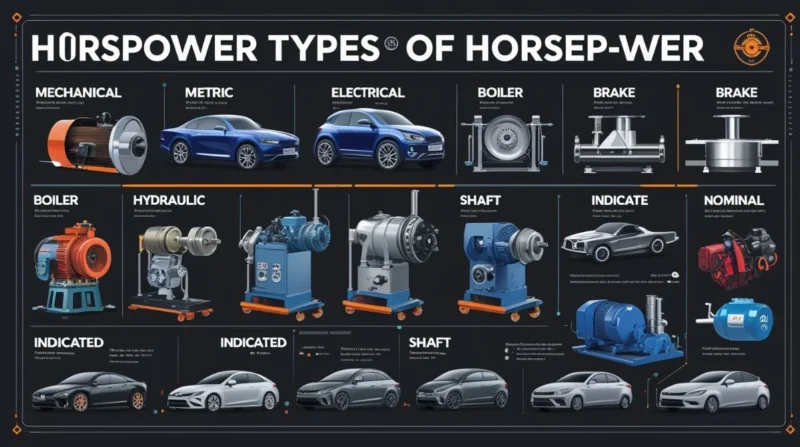Table of Contents
- What Is Power?
- Exploring Horsepower
- Decoding the Watt
- Converting Horsepower to Watts
- Historical Context
- Horsepower Standards Around the World
- How to Calculate Horsepower?
- Real-Life Applications of Horsepower
- Why Understanding Power Matters?
- Conclusion
Power plays an essential role in our everyday lives, influencing everything from the vehicles we drive to the devices we rely on at home. Two odf the most frequently used units for measuring power are horsepower (hp) and watts (W). By exploring their origins, differences, and applications, we can gain a deeper appreciation of how energy is produced, transferred, and consumed across various systems.
What Is Power?
In basic terms, power indicates the rate at which energy is consumed, produced, or transmitted within a given system. It quantifies how quickly work is done or energy is produced or consumed within a system. For instance, a light bulb with a higher power rating uses more energy over a shorter period than one with a lower rating.
Exploring Horsepower
The Historical Background of Horsepower
The term horsepower was introduced in the late 18th century by Scottish engineer James Watt. Seeking a relatable benchmark for the performance of steam engines, Watt equated their output to the work capacity of draft horses. He defined one horsepower as the ability to do 33,000 foot-pounds of work per minute.
Variants of Horsepower
While commonly associated with automobiles, horsepower comes in multiple forms depending on the field of use:
1. Mechanical Horsepower (Imperial)
Originally defined by James Watt, one mechanical horsepower is the equivalent of performing 33,000 foot-pounds of work per minute, which translates to approximately 745.7 watts.
2. Metric Horsepower
Known as Pferdestärke (PS) in German and chevaux vapeur (CV) in French, it equals about 735.5 watts. It’s standard in metric system countries.
3. Electrical Horsepower
“Primarily used to evaluate the performance of electric motors, one electrical horsepower is precisely equivalent to 746 watts. It is especially relevant in industrial and manufacturing environments.
4. Boiler Horsepower
Used to measure a boiler’s steam-producing capability, where 1 boiler horsepower equals the energy required to evaporate 34.5 pounds of water per hour at 212°F, or about 9,810 watts.
5. Hydraulic Horsepower
Describes the power in hydraulic systems and is calculated based on fluid pressure and flow rate, critical in industries like construction and mining.
6. Brake Horsepower (BHP)
Represents the engine’s power before any losses from auxiliary components (e.g., alternator, gearbox). It’s typically measured using a dynamometer.
7. Shaft Horsepower (SHP)
Indicates the power transferred to a drive shaft in systems like turbines and propellers. It’s commonly used in marine and aerospace engineering.
8. Indicated Horsepower (IHP)
The theoretical output produced within an engine’s cylinders, excluding mechanical losses. It’s useful for internal performance evaluations.
9. Nominal Horsepower
An early method for rating steam engines based on cylinder dimensions, not actual performance. Now obsolete, it has been replaced by more accurate measurements.
10. Tax Horsepower (Fiscal Horsepower)
A unit once used for taxation purposes, based on engine size rather than power output. Some countries still use this metric for vehicle registration.
Decoding the Watt
Definition and Origin
The watt, designated in honor of the renowned engineer James Watt, functions as the internationally recognized standard unit for measuring power within the International System of Units (SI).
Common Wattage Examples
Watts help quantify how much power household and industrial appliances consume or deliver:
• Standard light bulb: ~60 W
• Microwave oven: ~1,000 W (1 kW)
• Laptop charger: ~45–65 W
Knowing wattage ratings allows consumers to make smarter energy choices and manage electricity use effectively.
Converting Horsepower to Watts
Because both horsepower and watts quantify power, they can be interconverted using established conversion factors:
• 1 Mechanical HP = 745.7 W
• 1 Metric HP = 735.5 W
• 1 Electrical HP = 746 W
To convert:
• HP to watts: Multiply by the appropriate factor.
• Watts to HP: Divide the watt value by the same factor.
Historical Context
Prior to the widespread adoption of modern engines, horses served as the primary source of mechanical power. Early machines, like horse engines or treadmills, used equine power to drive tools such as grain mills or water pumps. These systems remained popular until steam and electric engines took over during the Industrial Revolution.
Horsepower Standards Around the World
Different applications and regions use slightly different standards for horsepower:
• Imperial (Mechanical): ~745.7 W
• Metric: ~735.5 W
• Electrical: 746 W
• Boiler: ~9,810 W
How to Calculate Horsepower?
One standard formula for rotating systems is:
Horsepower = (Torque × RPM) / 5252
Where:
• Torque is measured in pound-feet (lb-ft)
• RPM is revolutions per minute
This equation is widely used for determining the output of motors and engines.
Real-Life Applications of Horsepower
Automotive Sector
Horsepower is a critical indicator of a vehicle’s performance. It affects speed, towing capacity, and acceleration. Even electric vehicles use horsepower, alongside torque, to describe motor power.
Construction and Heavy Equipment
Machines like cranes, bulldozers, and excavators rely on horsepower ratings to indicate load capacity, operational efficiency, and durability.
Agricultural Industry
Modern agricultural tools, including tractors and harvesters, depend on horsepower for efficient field operations and timely harvesting.
Industrial Use
Generators, compressors, and other machinery in manufacturing plants are rated by horsepower to represent productivity and capability.
Household Equipment
Home appliances like lawn mowers and vacuum cleaners also use horsepower as a performance indicator, higher horsepower often means better functionality.
Recreational Vehicles
Jet skis, boats, and snowmobiles use horsepower ratings to define speed, handling, and engine strength, important for both safety and enjoyment.
Aviation
Aircraft engines must deliver adequate horsepower to produce the necessary thrust and sustain lift throughout flight. Understanding an aircraft’s horsepower rating helps in assessing performance limits and payload capacity.
Maritime Applications
Ships, ferries, and fishing boats need engines with robust horsepower to ensure steady movement, particularly over long distances or against strong currents.
Emergency Services
Vehicles like ambulances, fire trucks, and police cars use high-horsepower engines to ensure rapid response and effective performance under pressure.
Why Understanding Power Matters?
Being aware of how horsepower and watts function allows individuals and professionals to:
• Optimise Efficiency: Select energy-saving appliances.
• Cut Costs: Reduce unnecessary power usage.
• Assess Performance: Choose machines suited for specific tasks.
Conclusion
Horsepower and watts are two fundamental metrics that define power output and energy usage across various domains. By exploring their origins, differences, and applications, you gain the knowledge needed to make better decisions, whether you’re buying a car, choosing appliances, or working in engineering or construction. Understanding these units empowers you to approach energy use and performance metrics with greater confidence and clarity.









